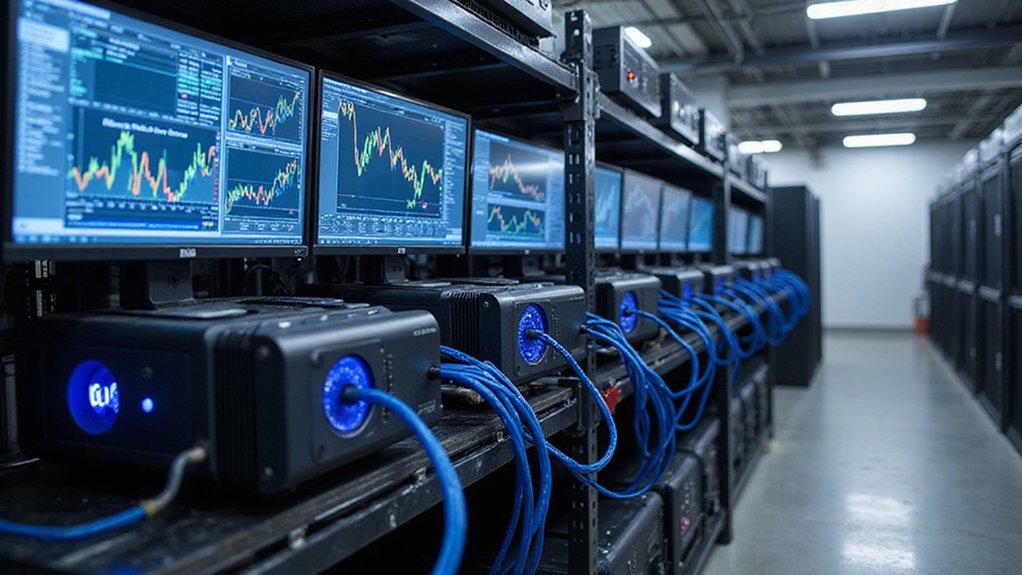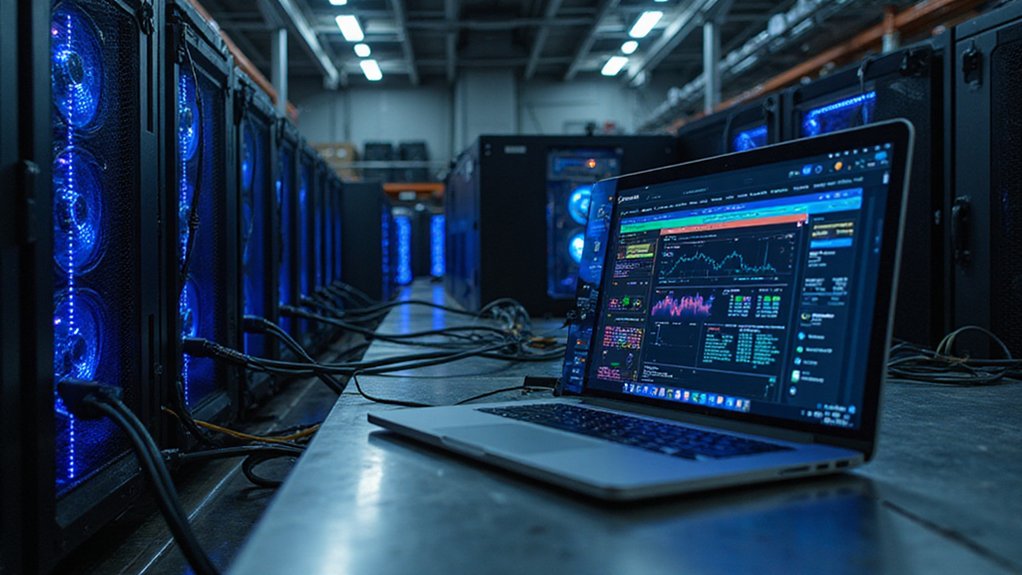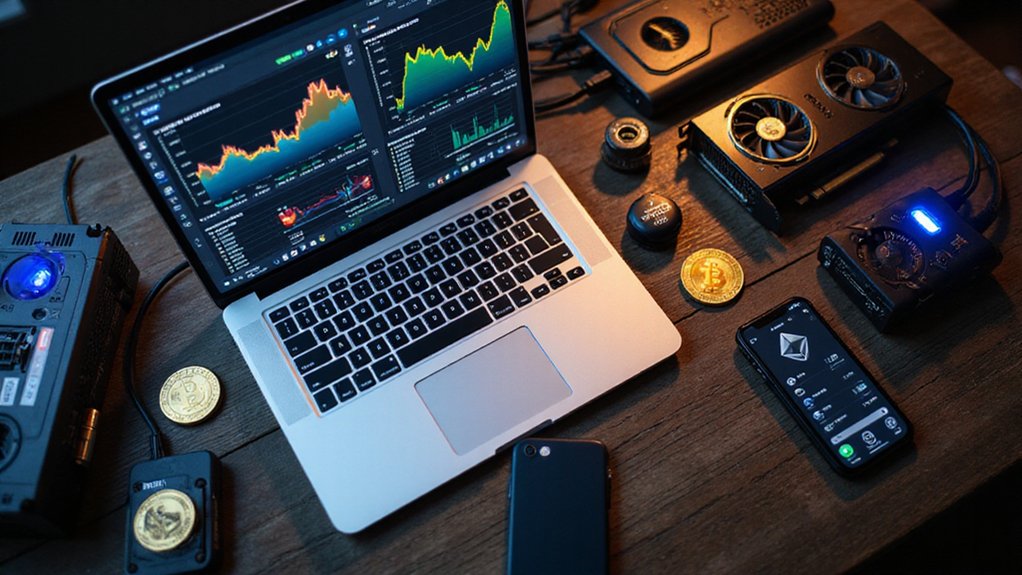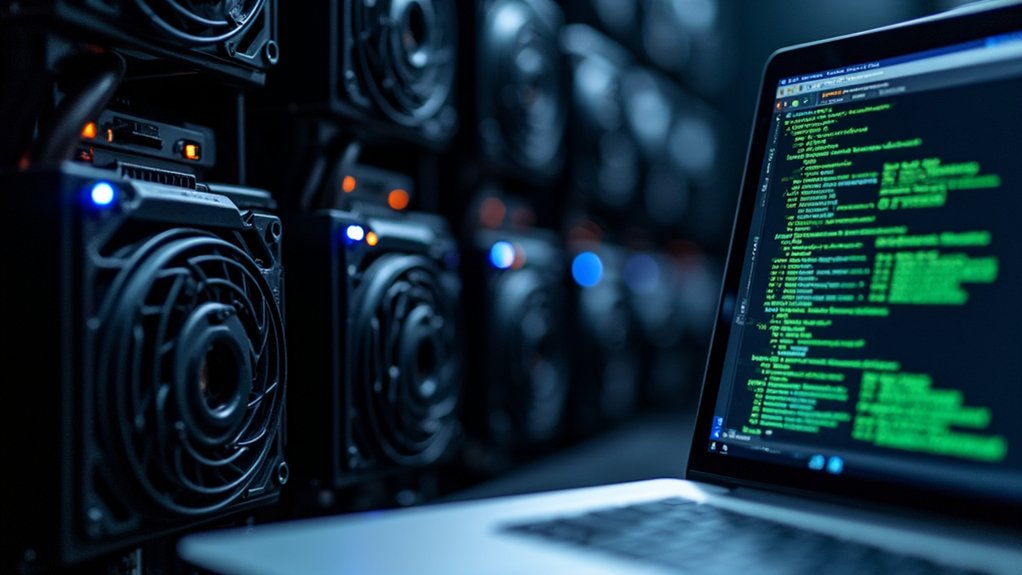CGMiner remains the grandfather of mining platforms, offering open-source flexibility that rewards technical sophistication while punishing newcomers with its command-line complexity. EasyMiner transforms the process into user-friendly point-and-click simplicity, though serious miners may find its limited features underwhelming. BFGMiner emphasizes power efficiency for ASIC operations, while Awesome Miner targets industrial-scale management. The choice between accessibility and advanced functionality ultimately determines whether mining ventures generate profits or expensive educational experiences—considerations that extend far beyond initial software selection.

While Bitcoin mining has evolved from a hobbyist pursuit into an industrial enterprise worth billions, the software powering these operations remains surprisingly accessible—though choosing the wrong platform can transform potential profits into expensive lessons in digital futility.
CGMiner stands as the grandfather of mining software, offering open-source flexibility and cross-platform compatibility that supports virtually every hardware configuration imaginable. However, its command-line interface demands technical sophistication that would make most beginners yearn for simpler times—assuming they don’t abandon the endeavor entirely after encountering its Byzantine setup procedures.
CGMiner’s open-source power comes wrapped in command-line complexity that transforms eager beginners into bewildered casualties of Byzantine setup procedures.
BFGMiner shares CGMiner‘s complexity while adding modular architecture specifically designed for ASIC and FPGA hardware. Its emphasis on low power consumption appeals to miners who understand that electricity costs can devour profits faster than a margin call in a bear market. Yet its limited GPU support and intimidating learning curve guarantee that only the technically inclined need apply.
For those preferring accessibility over absolute control, EasyMiner delivers exactly what its name promises: a graphical interface that transforms mining from arcane ritual into point-and-click simplicity. This beginner-friendly approach comes with predictable trade-offs—limited hardware compatibility and fewer advanced features that serious miners consider essential. Beyond its user-friendly design, EasyMiner also provides real-time mining statistics and robust security measures that make it particularly attractive for newcomers to the cryptocurrency mining space.
Awesome Miner targets industrial-scale operations with multi-rig management capabilities and thorough ASIC support. Its detailed dashboards provide the monitoring granularity that large mining farms require, though accessing premium features requires maneuvering the inevitable paywall that separates casual users from committed professionals.
MultiMiner occupies the middle ground between accessibility and functionality, offering cryptocurrency auto-switching that theoretically maximizes profitability while maintaining cross-platform compatibility. The software’s beginner-friendly interface masks relatively complex setup requirements that can frustrate newcomers expecting plug-and-play simplicity.
ECOS represents the cloud mining alternative, integrating advanced profitability tracking with seamless cloud-based operations. This approach appeals to miners seeking exposure without hardware headaches, though cloud mining’s economics deserve scrutiny given the industry’s checkered history with such arrangements.
The ideal choice ultimately depends on technical expertise, operational scale, and risk tolerance—factors that separate profitable miners from those who discover that digital gold mining requires considerably more than enthusiasm and optimism.
Frequently Asked Questions
How Much Electricity Does Bitcoin Mining Software Typically Consume Daily?
Bitcoin mining software’s daily electricity consumption varies dramatically based on hardware efficiency and network participation.
Individual miners typically consume enough power to cost approximately $30 daily in electricity bills, while single transactions can devour up to 1,200 kWh—roughly equivalent to powering an average American home for over a month.
The network’s collective daily consumption fluctuates with market conditions, as miners strategically adjust operations based on profitability calculations and equipment availability.
Can Bitcoin Mining Software Damage My Computer’s Hardware Over Time?
Bitcoin mining software can indeed inflict considerable hardware damage over time through sustained high-load operations and heat generation.
The continuous strain accelerates component degradation—particularly GPU fans and thermal interfaces—while overclocking practices (often employed to maximize hash rates) compound these risks exponentially.
Without proper cooling systems and regular maintenance protocols, miners frequently discover their expensive hardware exhibits markedly shortened lifespans, making the economics rather less attractive than initially anticipated.
Is Bitcoin Mining Software Legal in All Countries and Jurisdictions?
Bitcoin mining software enjoys decidedly uneven legal reception globally.
While permitted across most Western jurisdictions—including the United States and United Kingdom—nine countries maintain explicit prohibitions, specifically China (following its dramatic 2021 crackdown), Algeria, and Bangladesh.
Regulatory frameworks remain frustratingly fragmented, with some nations offering clear guidelines while others maintain studied ambiguity.
Miners must navigate this patchwork of evolving regulations, where today’s permissible activity could face tomorrow’s enforcement action.
What Internet Speed Is Required for Bitcoin Mining Software to Work Effectively?
Bitcoin mining software requires surprisingly modest internet speeds—ASIC miners function effectively with 10-20 Mbps, while GPU setups demand around 100 Mbps.
The real concern isn’t bandwidth (miners generate merely 100-200 MB monthly) but latency and stability. Sub-70ms response times prove essential, as delays in submitting solutions can cost miners their rewards to faster competitors.
Wired connections trump wireless reliability, making one’s internet infrastructure as important as the mining hardware itself.
How Long Does It Take to Earn One Bitcoin Using Mining Software?
Mining one Bitcoin currently takes approximately 10 days with decent hardware operating solo—though this assumes one actually solves blocks consistently, which remains laughably optimistic for individual miners.
Pool mining offers more predictable earnings but distributes the 3.125 BTC block reward proportionally among participants.
The perpetual dance between network difficulty adjustments and halving events guarantees these timeframes remain frustratingly fluid, making precise calculations about as reliable as cryptocurrency price predictions.









